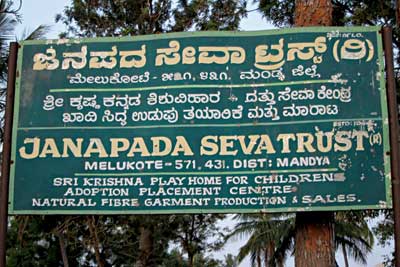 |
| The Janapada Seva Trust strives to create a nonviolent, egalitarian order of society. Its core area of work includes welfare, education, rural industry, environment and agriculture. |
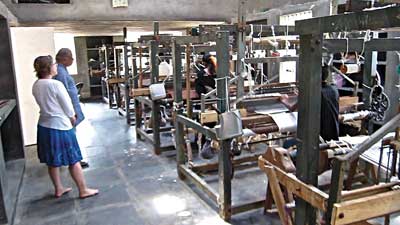 |
| The trust refurbished 11 wooden manual looms and created a space where local people can make “Khadi” cloth whenever they have a chance. |
By Eric Rector
Photos by the author
It all started with a bug in my ear. A friend had traveled to South India during college and now regularly returned to the same foundation – the Janapada Seva Trust (www.janapada.org) – where she had initially visited through a college program. My friend described the foundation’s work in detail, including its effort to encourage organic agriculture locally.
Having explored sustainable agriculture in Maine and Europe and China already, I became interested in a field-level view of the world’s second most populous country and the largest democracy. The opportunity for a visit occurred when my wife, Alison, had to travel to the Persian Gulf for an art program, a short (four-hour) and inexpensive plane ride away from Southern India. With her travel costs paid, I thought I should meet her in South India after her work was done.
A country as big as India contains several distinctive and geographically diverse cultures. Aside from its heavy Muslim and Hindu histories, the disputed territory of Jammu and Kashmir in the Himalayas is as far north as Santa Fe, New Mexico, and is heavily influenced by Tibetan Buddhism. The drip-tip bottom of the “sub-continent” is as far south as Colombia and is home to many Jainists and Christians. We flew into Bangalore in the state of Karnataka, which is only 400 miles from the bottom of the country, firmly in the subtropics, where the dominant crops are rice, cotton, coconuts, bananas, mango and sugar cane.
The grandson of the founder of the Janapada Seva Trust, Sumanas, met us at the train station in Mysore (a large city with historic ties to Sanskrit culture and language), roughly 30 miles southwest of Melkote. He loaded our luggage into the back of his well used Suzuki Omni van and launched us into the thick traffic exiting the train station. A few miles out, the press of ox carts, auto rickshaws, motorbikes, cars, trucks and buses lightened, and we began to gain speed along the main highway between the ancient city of Mysore and the modern tech capital of Bangalore, 90 miles away, and soon we branched north into the hills. Eventually we passed several houses, then a walled school compound, slowed to enter a town, turned left and climbed up a hill and finally turned into a courtyard flanked by several buildings. A large sign on the corner announced the trust and its work in English and Kannada script. Sumanas cut the engine, and the normal stillness of the town settled over us, with sounds of bird calls, insect hums and the occasional blurt of livestock or humans. On the town street, a resident led his cows and goats past us, heading home for the evening milking.
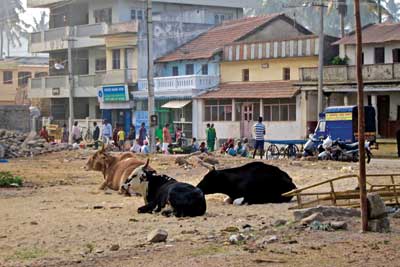 |
| The “sacred cows” of India – and goats and sheep and buffalo – literally wander the streets of Melkote undisturbed. |
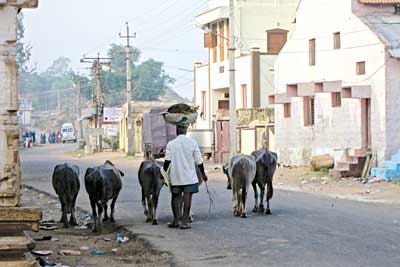 |
| A local resident with his herd of cows. |
I was stunned to learn how the dairy industry in that area works. I saw no “dairy farms” that we would recognize but simply households that care for one or a few dairy animals in their backyards. Every morning and evening the household dairy stock are milked. From this milk supply the household reserves milk for itself, it sells some directly to neighbors, and any surplus is carried in covered metal buckets down the streets of the town to the dairy cooperative building situated on the main road heading back to Mysore. Extra milk is poured into the bulk cooling tank, and families are credited for their contribution. Later in the day a dairy tanker picks up the milk from the bulk tank and takes it to a processing plant to be packaged. In the morning after milking, the dairy animals are walked out of their yards to a spot around town to graze for the day, largely un-penned. They are collected in the evening, taken home and milked again. Yes, the “sacred cows” of India – and goats and sheep and buffalo – literally wander the streets of Melkote undisturbed.
Sumanas led us inside the house, where the 80-year-old founder of the trust welcomed us warmly with many questions about where we came from and how we got there. Sumanas then took us to his uncle’s house, several blocks away, where we would be lodging. He told us when dinner would be served at the main house and made sure we knew how to find it. On our walk to dinner, we passed a troop of bonnet macaque monkeys playing and grooming on the balconies and roofs of several homes.
The days that followed ticked by at a languid pace, with relaxed meals and midday siestas (it was the hot season, well over 90 F every day) and with some travel around Melkote, mostly between our hosts’ house and their demonstration farm. Still we were able to experience so much, especially regarding the work that the trust was doing for its community. Its main focus is on sustainable wages and agriculture, from seed to finished product and back to seed.
Cotton, thought to have been domesticated in the Indus Valley thousands of years ago, is a major crop in South India, and although the Indian government has blocked genetically engineered (GE) food crops for now, GE Bt cotton (cotton engineered to contain the insecticidal toxin produced by the bacterium Bacillus thuringiensis) is planted in 97 percent of the country’s cotton fields according to ag consultant Phillips McDougall. According to Wikipedia, in 2014 India was a close second to China in volume of cotton production among countries.
The trust says that the average size of an individual farmer’s cultivated land in South India is 2 acres and is largely worked by hand and by livestock. As with most commodity crops, the profit margin for commercial cotton is low. The added cost of buying GE seeds, as well as the specific herbicides they require, threatens the sustainability of average cotton farmers, who generally have nothing else to do with their crop than to sell it for whatever the local wholesale buyer will offer, since commercial spinning and textile operations have long since shifted away from the rural areas.
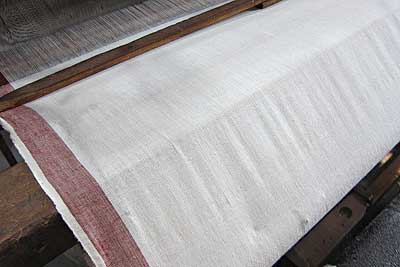 |
| Khadi cloth |
 |
| The trust sources both certified organic cotton thread and local non-genetically engineered “khadi thread” and dyes them with traditional techniques using agricultural materials. |
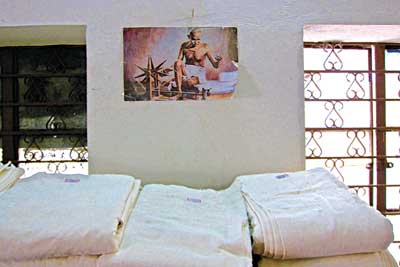 |
| Khadi cloth piled beneath a picture of Mahatma Gandhi. “Khadi” means “home spun” and encompasses a Ghandian movement of self-reliance. |
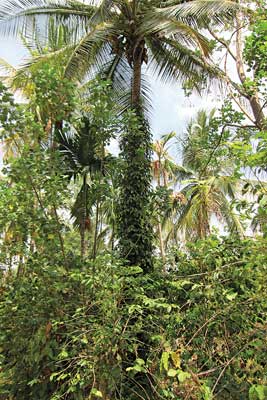 |
| Coconut, coffee and pepper plants grow together in the demonstration farm. |
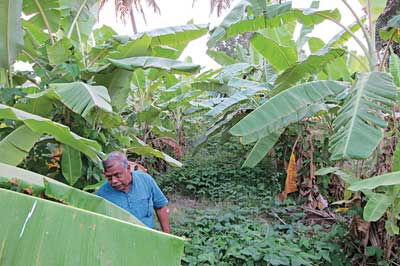 |
| Using techniques similar to those of permaculture, the trust cultivated a banana grove that was in its fifth productive year, compared with one or two years typical of conventional banana groves. |
The trust is changing that situation for farmers who want to work with the foundation. First it found and refurbished 11 wooden manual looms and created a space where farmers and/or their families could work for a specific hourly wage whenever they had a chance. The trust sources both certified organic cotton thread from the Alliance for Sustainable & Holistic Agriculture (ASHA, www.kisanswaraj.in), as well as local non-GE “khadi thread.” The trust dyes its thread with traditional techniques using agricultural materials (indigo for blue, pomegranate peels and/or myrobalan fruits for yellow, betel nuts and/or madder root for beautiful rich reds). It then sells its cloth locally as “Khadi,” a term that literally means “home spun” but actually encompasses a Ghandian movement of self-reliance. “Khadi is the sun of the village solar system,” Gandhi is quoted as saying.
Khadi cloth is highly valued all over India, Pakistan and Bangladesh and is increasingly rare. Part of the profit from sales of finished cloth goes back to the farmers and weavers, and part supports and expands the trust’s program. Ultimately the trust would like to transfer an established weaving cooperative to the weavers for their full benefit. This simple, virtuous circle increases planting of certified organic and traditional cotton in the area, offers comparatively high wages to anyone working on a loom, and gives urban Indians access to cloth and garments in traditional designs and colors.
The trust also runs a demonstration farm growing some of the dominant crops of the area – coconuts, bananas, betel nut, coffee, mangoes, black pepper – using a combination of traditional techniques plus newer, sustainable methods such as permaculture and drip irrigation. The purpose is to show alternatives to farmers who have been told that the “best” way to grow these crops is intensively with chemical fertilizers and a myriad of herbicides and other pesticides.
For example bananas normally are started with planting slips (which the farmer has to buy) followed by one or two harvests before the plot is plowed and replanted with another crop of new banana slips for another two-year cycle. At the trust I saw a banana grove in its fifth productive year that benefited from a simple combination of compost and permaculture ditches between rows of banana plants, which replaced the need for fertilizer and captured moisture in the dry seasons, reducing water use.
Coconuts are planted in longer-term groves but require a lot of water, which is normally delivered by periodically flooding ditches among the trees. This limits these groves to lowlands that can be irrigated this way. The trust has shown that a simple drip irrigation system enables farmers without lowland access to grow coconuts and other perennial crops productively almost anywhere using much less water.
Area coffee plantations often have mature hardwood trees interplanted to provide shade, but this technique takes many years – often decades – to establish. The trust farm added coffee and black pepper vines to the shade under a productive coconut or betel nut grove, watering all these crops with the same drip system. Although they won’t grow in the same density as under hardwoods, they can provide extra cash crops without extra land.
These are examples of only a portion of the trust’s work. According to its website, “Inspired by the ideals of Mahatma Gandhi and Sarvodaya philosophy the trust has been striving to create a non-violent, egalitarian order of society. Its core area of work is welfare, education, rural industry, environment and agriculture.” This is truly a local organization focused on the needs and concerns of its neighbors and region. It is the primary work of a single family now in its third generation. Sumanas, who picked us up at the train station, is now beginning work on a Ph.D. at Oxford University in the UK where he hopes to further develop, enhance and document the philosophy of the trust’s work. He expects to return to Melkote and continue leading the trust in the footsteps of his father, Santosh, and grandfather/founder, Surendra.
One night, as the family invited us to sit with them on the porch to chat as the evening slowly cooled, I was amazed to learn that among many of the influences of their work (such as Gandhi, and Masanobu Fukuoka’s book “The One-Straw Revolution”) was an American named Scott Nearing. Both Surendra and Santosh had read “Living the Good Life,” but their copy had fallen apart and they could not find another copy of it or any other Nearing book in India. We were immediately delighted because we had brought them a gift of maple syrup from Maine – frequently mentioned in those books but unknown in South India. And as soon as I got back to Maine, I sent them a box of books in thanks for their gracious generosity in hosting us, and with best wishes in their continued good work.
About the author: Eric Rector owns Monroe Cheese Studio in Monroe, Maine, and is on the board of the Maine Cheese Guild.
Additional Resources
The Flying Shuttles of Melkote, https://www.livemint.com/Sundayapp/0sdXIIUg7aXAdhlK13LYEL/The-flying-shuttles-of-Melkote.html
A short video of the trust’s looms in use: https://youtu.be/AS0McfZ5Gbg
